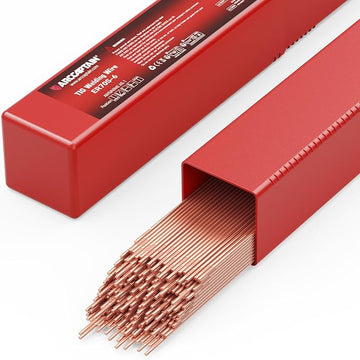TIG Welding Rods
- En vedette
- Meilleures ventes
- Alphabétique, de A à Z
- Alphabétique, de Z à A
- Prix: faible à élevé
- Prix: élevé à faible
- Date, de la plus ancienne à la plus récente
- Date, de la plus récente à la plus ancienne
Arccaptain’s TIG welding rods collection brings welders the filler rods and accessories needed for smooth, reliable TIG welds.
Each rod is crafted for precision and consistency, enabling you to tackle a wide range of materials, including aluminum, stainless steel, mild steel, and magnesium alloys, all with superior arc stability and weld strength.
If building strong, clean joints matters most, Arccaptain has TIG welding rods ready for every welding style and project.
TIG Welding Rods That Deliver Perfect Welds for Pros and New Welders
Welders use TIG welding rods to join different metals with minimal spatter and maximum control. This collection makes sure each rod melts cleanly, with smooth bead formation, allowing repairs and fabrication projects to meet high standards.
TIG welding rods from Arccaptain improve every weld
- Consistent, easy arc starts with every weld
- High-strength filler rods for a range of metals and alloys
- Minimal slag and spatter for easy cleanup
Get Clean TIG Welds Fast With Precision Rods
Precise TIG welding rods mean less rework. Each rod is designed to deliver a steady feed and create even, shiny weld bead lines that look good and last longer. Arccaptain’s collection helps anyone welding thin or thick materials get great results.
- Color-coded rods for quick identification and setup
- Premium alloys for better weld penetration and durability
- Suitable for various power sources and machines
Alloy Selection Solves Welding Challenges
Steel, stainless, or aluminum—TIG welding rods here fit nearly every job and finish requirement. With options for ER308L for stainless, ER70S-6 for mild steel, and more, there’s a rod in this collection for any project and every skill level.
- Multiple rod types for specialized welds
- Fine-tuned compositions for strength and corrosion resistance
- Easy-to-use fillers support beginner to advanced welders
Tig Welding Rods That Keep Your Arc Stable and Your Bead Tidy
Short blurb: Arc starts should be quick. Wetting should be even. These rods help your puddle flow where you want it.
Cleaner Puddle, Fewer Inclusions
Reliable deoxidizers and tight chemistry reduce porosity. Your bead stays bright and uniform.
- Even wetting along toes of the weld
- Low slag, simple post-weld brush
- Consistent bead profile for repeatable passes
Predictable Performance Across Settings
Whether you run AC on aluminum or DC on steel, keep the puddle calm and controlled.
- Stable arc start and steady feed
- Compatible with pure argon shielding gas
- Works across common joint types and positions
Explore Related Arccaptain Collections
- TIG Electrodes — Color-coded tungstens for fast ID and steady starts.
- Stick Welding Accessories — Find clamps, rods, and parts that support stick welding projects for beginners and pros.
- TIG Welding Wires — More filler choices to match alloys and thickness.
FAQs About TIG Welding Rods
What TIG welding rods do I use for mild steel?
For mild and low-alloy steel, most welders use ER70S-2 or ER70S-6 filler rods. These rods provide good strength, ductility, and smooth weld puddle control when running DC with argon shielding gas. ER70S-6 is especially popular because it handles mill scale and rust better. They are reliable for both shop and field work.
What TIG welding rods are best for stainless steel?
The best rod depends on the grade of stainless you are welding. For common 300-series stainless like 304 or 316, use matching fillers such as ER308L, ER309L, or ER316L. Choosing the right rod keeps corrosion resistance, color match, and mechanical properties consistent. Always confirm the filler matches the base metal series.
Which TIG welding rods should I use for aluminum?
For aluminum, the rod must match the type of alloy you are welding. ER4043 is commonly used on cast parts and gives smooth flow, while ER5356 works well on wrought plate and extrusions for stronger joints. Always run AC with argon shielding to get proper cleaning action on the weld. Match the rod to the job for best results.
What rod diameter should I pick?
Choose rod size based on the thickness of the base metal. Small diameters like 1/16" are better for thin sheet because they control heat and prevent burn-through. Larger diameters like 3/32" or 1/8" are better for thicker joints to deposit filler faster. Start small, then size up as the material gets thicker.
Can I use one TIG welding rod for everything?
It’s not recommended to use just one filler for all jobs. Each base metal needs a specific rod to get strong welds, prevent cracking, and maintain properties like corrosion resistance. Using the wrong rod can cause weak joints and poor appearance. Matching the filler to the metal gives the best results.
Do TIG welding rods have an expiration date or go bad?
TIG rods don’t have an expiration date, but they can get contaminated if stored poorly. Moisture, oil, and dust on the rods can cause porosity or weak welds. Keep them sealed in a dry container or tube to protect them. Wipe rods clean before use to ensure a strong, clean weld.

